Product Images Progesterone
View Photos of Packaging, Labels & Appearance
- The structural formula is - progesterone capsules 01
- Table 1 - progesterone capsules 02
- Table 2 - progesterone capsules 03
- Table 3 - progesterone capsules 04
- Figure 1 - progesterone capsules 05
- Table 4 - progesterone capsules 06
- Table 5 - progesterone capsules 07
- Table 6 - progesterone capsules 08
- Table 6 - progesterone capsules 09
- Table 7 - progesterone capsules 0a
- NDC 0054-0829-25ProgesteroneCapsules100 mgDO NOT USE IF ALLERGIC TO PEANUTS100 Capsules - progesterone capsules 0b
- NDC 0054-0830-25ProgesteroneCapsules200 mgDO NOT USE IF ALLERGIC TO PEANUTS100 Capsules - progesterone capsules 0c
Product Label Images
The following 12 images provide visual information about the product associated with Progesterone NDC 0054-0829 by Hikma Pharmaceuticals Usa Inc, such as packaging, labeling, and the appearance of the drug itself. This resource could be helpful for medical professionals, pharmacists, and patients seeking to verify medication information and ensure they have the correct product.
Table 1 - progesterone capsules 02

This is information regarding the Pharmacokinetic Parameters of Progesterone, showing data for different dosages of Progesterone capsules. The table includes parameters such as Cmax, Tmax, and AUC values for daily doses of 100mg, 200mg, and 300mg. The data provides insight into how the drug is absorbed, distributed, metabolized, and eliminated in the body at different dosage levels.*
Table 2 - progesterone capsules 03

This text provides a table showing the mean pharmacokinetic parameters for Estradiol, Estrone, and Equilin in postmenopausal women after the coadministration of Conjugated Estrogens 0.625mg and Progesterone Capsules 200mg for 12 days. It includes data on parameters such as AUC (Area Under the Curve) and drug levels in ng/mL over certain time intervals. The table also clarifies that total estrogens consist of both conjugated and unconjugated estrogen levels.*
Table 3 - progesterone capsules 04
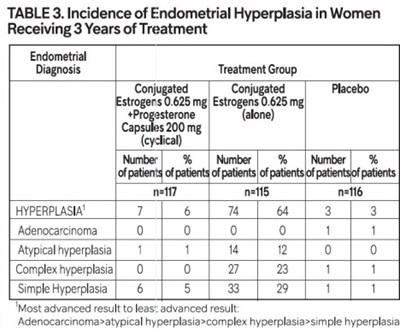
This is a table displaying the incidence of endometrial hyperplasia in women who received 3 years of treatment with different hormonal regimens. The treatments included Conjugated Estrogens (0.625 mg) alone, Conjugated Estrogens (0.625 mg) + Progesterone (alone) capsules (200 mg), and Placebo. The table shows the number and percentage of patients in each treatment group who were diagnosed with different types of hyperplasia, including Simple Hyperplasia, Atypical Hyperplasia, and Adenocarcinoma. The text also notes the order of severity based on the diagnoses, with Adenocarcinoma being the most advanced result.*
Figure 1 - progesterone capsules 05
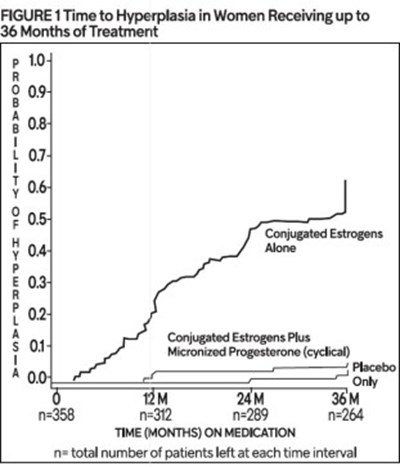
This is a graph labeled "FIGURE 1 Time to Hyperplasia in Women Receiving up to 3 Months of Treatment". The graph shows data related to the time it takes for hyperplasia to occur in women undergoing treatment for up to 3 months. It appears to display the number of patients remaining at each time interval.*
Table 4 - progesterone capsules 06

This table provides information on the discontinuation rate due to hyperplasia over 36 months of treatment with conjugated progesterone and placebo. The most advanced biopsy results include adenocarcinoma, atypical hyperplasia, complex hyperplasia, and simple hyperplasia. It shows the number and percentage of patients in each category for each treatment group.*
Table 5 - progesterone capsules 07

This text provides a detailed table showing the relative and absolute risks observed in the Estrogen Plus Progestin Substudy of WHI over an average of 5.6 years. It includes information on various health events such as coronary heart disease events, strokes, venous thrombosis, fractures, cancers, and mortality rates. The data is presented as relative risk, absolute risk per 10,000 women-years, and confidence intervals. The table also mentions the Global Index, which is a combination of specific health events. The information presented here is adapted from multiple publications related to the WHI study and provides valuable insights into the risks associated with estrogen plus progestin use.*
Table 6 - progesterone capsules 08
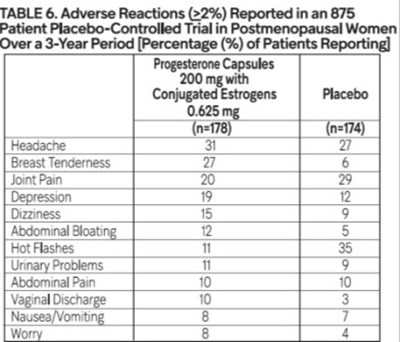
This is a table showing adverse reactions reported in a 875-patient placebo-controlled trial in postmenopausal individuals over a 3-year period. Adverse reactions include headache, breast tenderness, joint pain, depression, dizziness, abdominal bloating, abdominal pain, vaginal discharge, nausea/vomiting, and worry.*
Table 6 - progesterone capsules 09
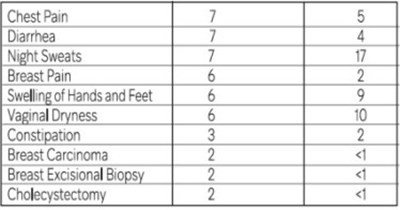
This text contains a list of potential symptoms, conditions, and medical procedures related to chest pain, diarrhea, night sweats, breast pain, swelling of hands and feet, vaginal dryness, constipation, breast carcinoma, breast excisional biopsy, and cholecystectomy. It also includes some unclear abbreviations at the end.*
Table 7 - progesterone capsules 0a

This is a table showing the adverse reactions reported in patients using 400mg/day in a placebo-controlled trial with estrogen-primed postmenopausal women. The table lists various adverse experiences along with the percentage of patients affected by each reaction. Common reactions include abdominal pain, fatigue, diarrhea, and headache. This data can be used to assess the frequency and types of adverse effects associated with the use of progesterone capsules.*
NDC 0054-0829-25ProgesteroneCapsules100 mgDO NOT USE IF ALLERGIC TO PEANUTS100 Capsules - progesterone capsules 0b

This description includes information about a progesterone capsule with a dosage of 100 mg, with a caution for individuals allergic to peanuts. It also mentions the manufacturer being Procaps SA for Hikma Pharmaceuticals USA Inc. The usual dosage instructions and storage conditions are provided, along with details on the active ingredient and the need to dispense the product with patient information.*
NDC 0054-0830-25ProgesteroneCapsules200 mgDO NOT USE IF ALLERGIC TO PEANUTS100 Capsules - progesterone capsules 0c
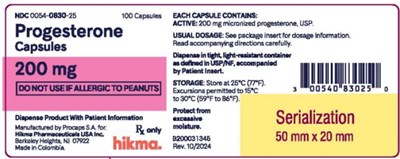
Description: The text provides information about NDC0054-0830-25 capsules, each containing 200 mg micronized progesterone, USP, with a usual dosage recommended. It is advised to store the capsules in a tight, light-resistant container at temperatures between 15°C to 30°C (59°F to 86°F) as per USP/NF guidelines. The text also mentions serialization details and a revision date of October 2024.*
* The product label images have been analyzed using a combination of traditional computing and machine learning techniques. It should be noted that the descriptions provided may not be entirely accurate as they are experimental in nature. Use the information in this page at your own discretion and risk.
